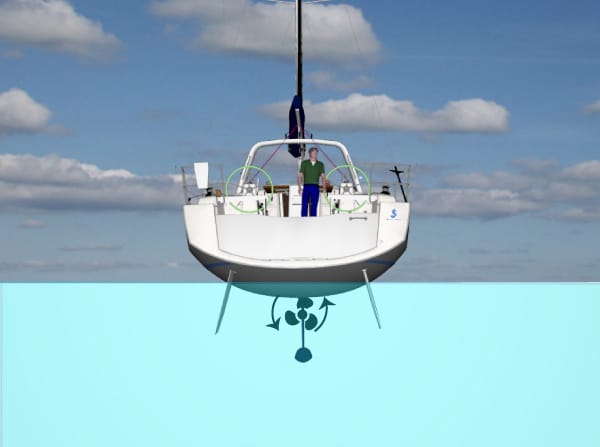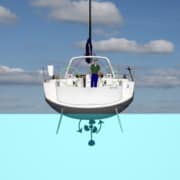Dual Rudder Monohulls
Dual Rudder Operations
When a monohull sailboat has dual rudders, the boat will act with different characteristics than with a single rudder. Thus, the point of this module is to help you maneuver a dual-rudder monohull sailboat.
Many modern new boats have dual rudders. However, don’t confuse dual rudders with dual helms. Dual helms do not necessarily mean dual rudders. You’ll have to either check the actual boat specs to see if it has dual rudders under the water or go for a swim.

Under sail, a dual rudder configuration has the advantage of having more rudder surface area in the water than a single rudder. Thus, it is more maneuverable, and controllable, and it has less tendency to round up into the wind with a gust. It can also make the boat sail to windward more.
The trade-off is the boat is less maneuverable under power and when docking – which is where the accidents happen.
Propeller wash over the Rudder
As you learned in the previous modules, with single rudder monohulls, the rudder is mounted directly aft of the propeller and so any time the boat engine is in forward gear, the wash from the propeller is directly onto the rudder. This gives you the ability to maneuver the stern of the boat in any direction you would like with no boat/rudder speed through the water – just a thrust of prop wash.
With dual rudders, the wash from the propeller does not flow over the rudder so you lose the ability to use this as a maneuvering tool.
Having no propeller wash makes it very difficult to effectively use spring lines during docking because you cannot leverage the opposing force vectors between the rudder force from propwash and the dockline from the dock to the boat.
For this reason, most dual rudder boats have a bow thruster. A bow thruster is an electric motor mounted sideways under the water line at the bow of the boat. The bow thruster pushes water either to port or starboard depending on how you want the bow to move. This makes maneuvering much easier and can keep you out of trouble.
Below is an animation of the bow thruster “actually working” and pushing the bow thruster to the dock.
A strong note: Don’t operate the bow thruster when your boat is doing greater than 1.5 knots of speed. The bow thruster is not designed for it and things can be bent and broken.
But be aware, that having a bow thruster can give you a false sense of security. Unless you practice maneuvering often in different wind conditions, you can get into some serious docking trouble and thus hull damage.
And – what if the bow thruster stops working? This is not an unrealistic situation. Our bow thruster has failed 3 times in the last 3 years and usually, it takes a long time to fix. What are you going to do – not go sailing until your bow thruster is fixed?







